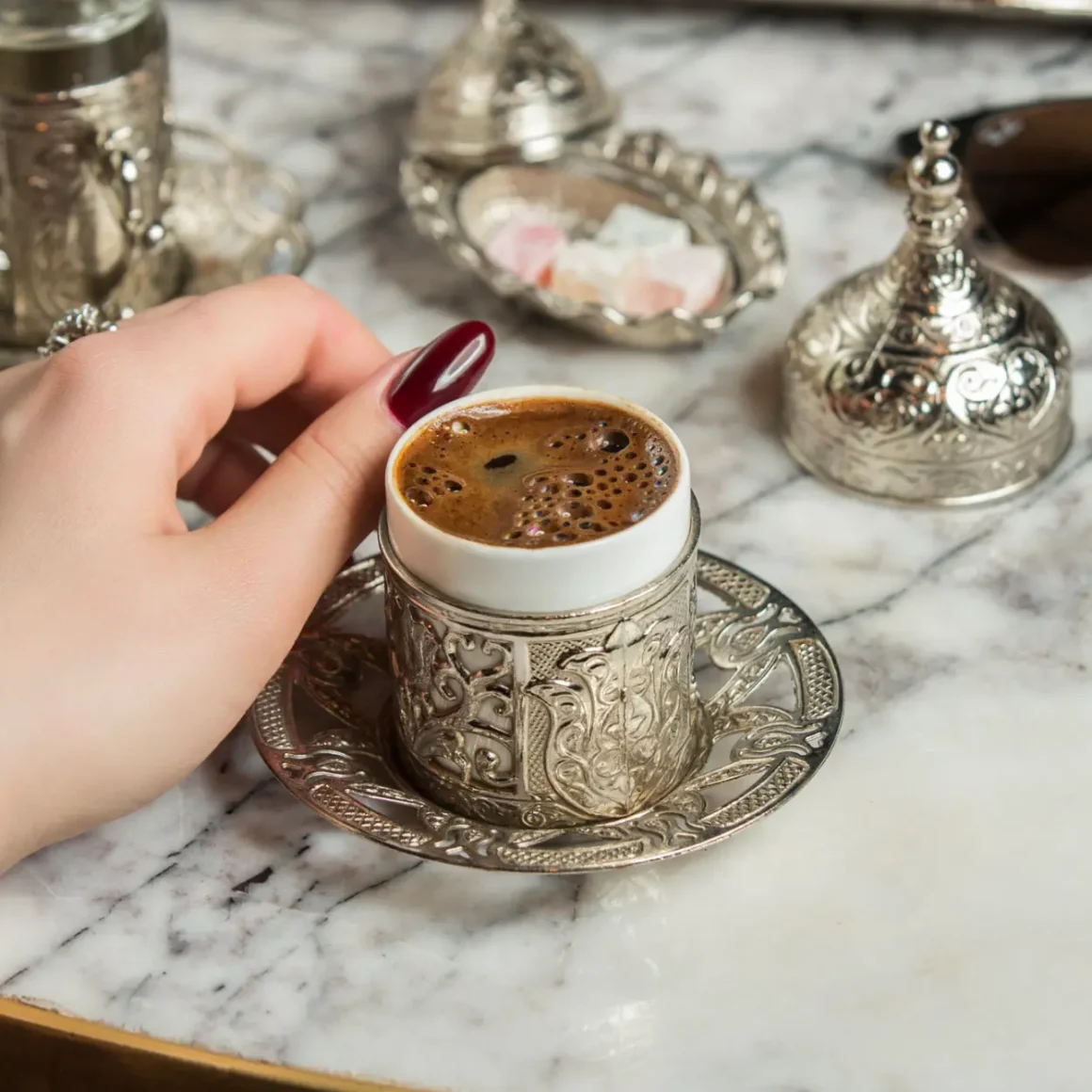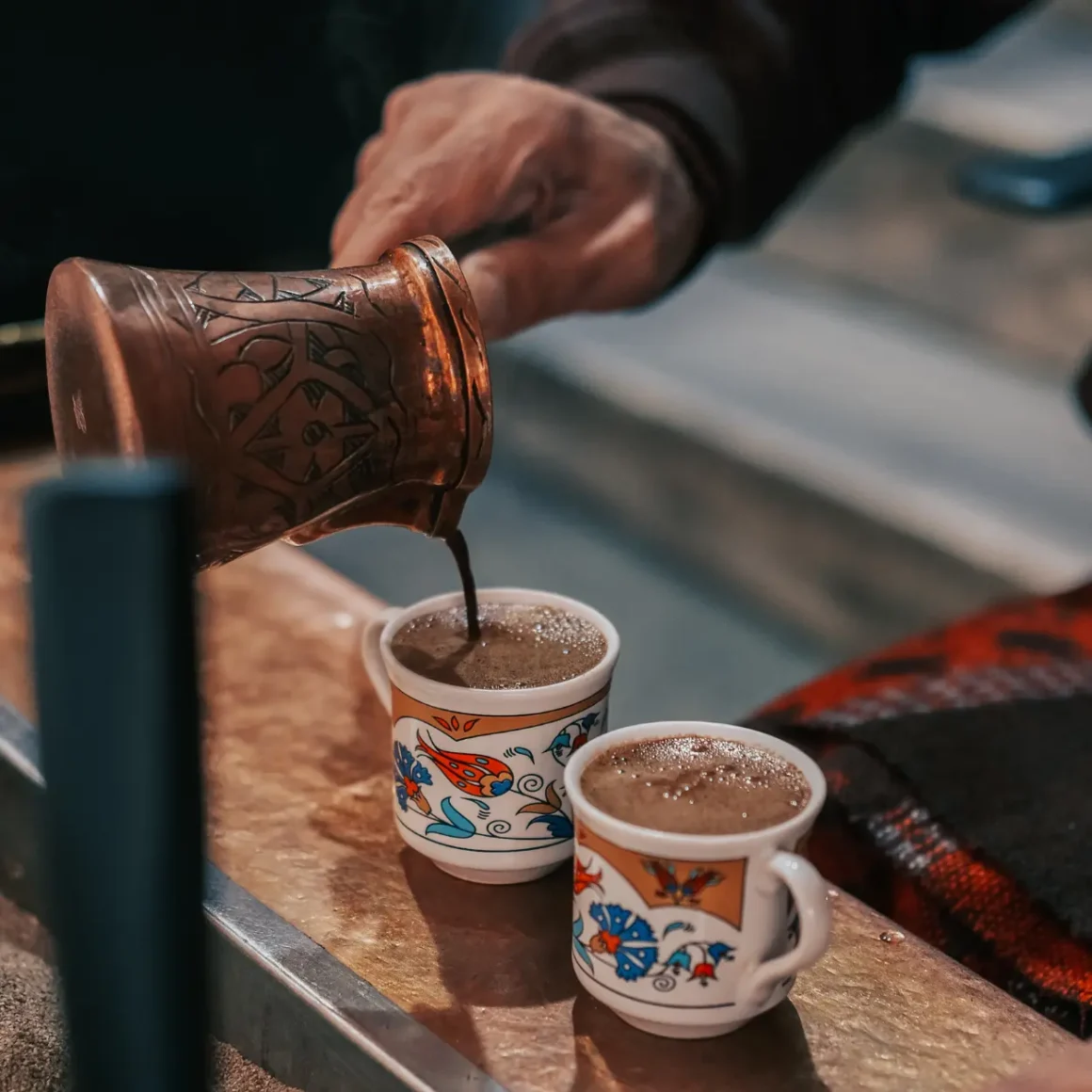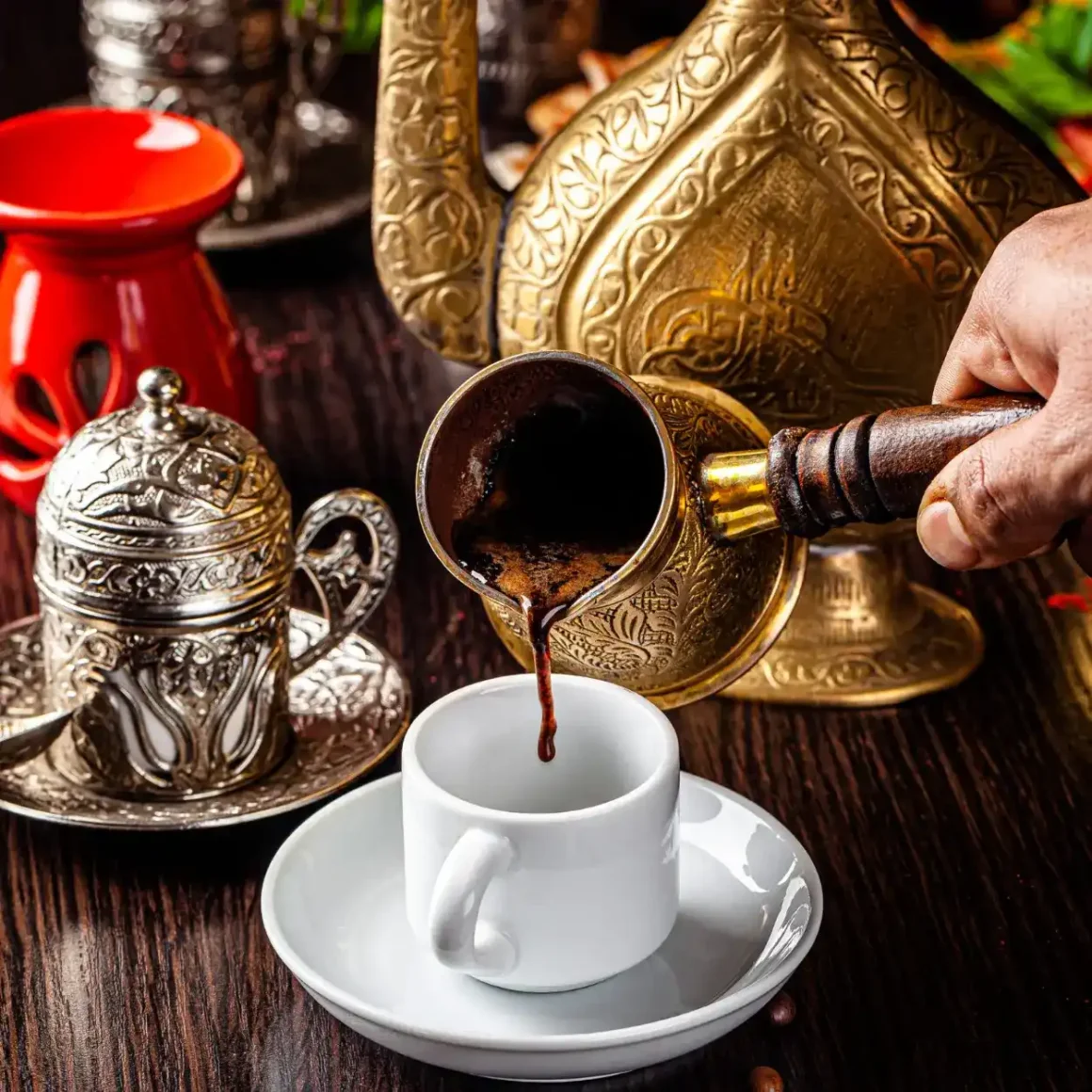Delve into the captivating realms of coffee where the rich legacy of Turkish coffee intersects with the dynamic zest of espresso. These two brewing methods stand as beacons of cultural heritage and contemporary preference, each with its own story to tell. Turkish coffee vs espresso is not just a comparison of drinks but a tale of contrasting traditions, methods, and flavors that have charmed coffee enthusiasts across the globe. From the finely ground beans of the former, savored slowly amidst conversation and connectivity, to the swift, intense rush of the latter embraced in the fast-paced buzz of modern life—both brews command a loyal following.
As we explore the nuances that define them, we uncover not only the intricate processes that give rise to these beloved beverages but also the ways in which they have become ingrained in the fabric of society. Join us as we celebrate the art and science behind these celebrated pillars of the coffee world.
Feeling a bit lazy to read? Hit play and listen to the article below.
- Introduction & Key Differences
- https://app.mysoundwise.com/tracks/16996575587859321e.mp3
- What is Turkish Coffee?
- https://app.mysoundwise.com/tracks/16996576112759065e.mp3
- What is Espresso?
- https://app.mysoundwise.com/tracks/16996576548960391e.mp3
- Flavor Profiles
- https://app.mysoundwise.com/tracks/16996576915320679e.mp3
- Brewing Techniques
- https://app.mysoundwise.com/tracks/16996577316075850e.mp3
- Serving and Presentation
- https://app.mysoundwise.com/tracks/16996577666609116e.mp3
- Cultural Significance
- https://app.mysoundwise.com/tracks/16996578022766099e.mp3
- Health Benefits and Drawbacks
- https://app.mysoundwise.com/tracks/16996578385285295e.mp3
- Modern Trends and Fusion
- https://app.mysoundwise.com/tracks/16996578749970679e.mp3
- Conclusion & FAQs
- https://app.mysoundwise.com/tracks/16996579075564897e.mp3
Espresso vs Turkish Coffee: Key Differences
- Cultural Roots and Rituals: Turkish coffee and espresso each carry deep cultural significance, embodying the traditions and social customs of their respective origins. Understanding these drinks involves more than taste—it’s about appreciating the history and rituals that surround their consumption.
- Brewing Techniques: The methods of preparing Turkish coffee and espresso are distinct and intricate, influencing the final flavor profile. Turkish coffee is brewed slowly with its grounds, creating a thick, potent concoction, while espresso is extracted under high pressure for a concentrated shot.
- Flavor and Aroma: These beverages offer vastly different sensory experiences. Turkish coffee is known for its strong, complex flavors, often enhanced with spices, while espresso is celebrated for its rich crema and intense, pure coffee essence.
- Presentation and Service: Presentation is key in both drinks, from the traditional cezve and cup for Turkish coffee to the classic demitasse for espresso. The presentation reflects the identity and philosophy behind each drink, enhancing the overall experience.
- Adaptation and Evolution: Both Turkish coffee and espresso continue to evolve, influencing modern coffee trends and preferences. From cold-brew versions to creative fusion blends, these age-old favorites are being reimagined to satisfy contemporary tastes and lifestyles.
What is Turkish Coffee?

Turkish coffee is a brewing method steeped in tradition, renowned for its strong, full-flavored profile and its cultural significance in the regions that encompass the former Ottoman Empire.
The origin and history of this delicacy traces back to the vibrant commerce and cultural exchanges of the Ottoman Empire. Its journey to becoming a globally recognized beverage is as flavorful as the coffee itself.
Introduction to the Ottoman Empire:
- The introduction of this coffee drink is often attributed to the nomadic merchants who traversed the trade routes of the 16th century. (1)
- Historically, Özdemir Pasha, the Yemeni governor, is credited with offering the beverage to Sultan Suleiman the Magnificent.
Controversy and Acceptance:
- The coffee’s potency led to its initial classification as a narcotic, according to the stringent interpretations of Islamic law at the time.
- Sultan Murad IV’s prohibition of coffee signifies the struggle between the beverage’s cultural uptake and conservative religious views. Despite this, the overwhelming allure of coffee led to the lifting of the ban.
Expansion Beyond the Empire:
- By the mid to late 17th century, the appreciation for this delectable beverage had crossed over into Western Europe.
- The establishment of the first coffee house in Britain by an Ottoman Jew marked a significant point in the beverage’s international expansion.
The historical narrative of Turkish coffee is not just about the emergence of a beverage but also about the social and cultural dynamics of its time. From the courtyards of Sultans to the salons of Europe, this coffee has been served, debated over, and celebrated, eventually earning its place among the best coffee experiences in the world. Its rich history mirrors the complex flavors it is known for, and together, they weave a tapestry of heritage that continues to be savored in cups across the globe.
What is Espresso?

Espresso coffee boasts an intensely rich flavor, served in compact, robust shots that underscore its deep taste and aromatic allure. Celebrated for its full-bodied profile, espresso stands as a cultural icon with a fascinating narrative of origin and development.
Origins and Invention:
- The journey to perfect espresso coffee began with Louis Bernard Rabaut, who crafted the first coffee machine in France in 1822, laying the groundwork for future espresso machines. (2)
- Notably, in 1855, Edouard Loysel de Santais built upon this invention with a machine capable of brewing a large volume, although not specifically producing espresso.
Evolution of Espresso Machines:
- Angelo Moriondo’s 1884 steam-driven coffee maker patent often leads to the misconception that he invented espresso. Nevertheless, his innovations were pivotal in the development of espresso technology.
- The true pioneering espresso machine came from Luigi Bezzera in 1901, with Desiderio Pavoni later commercializing this design in 1903, solidifying the standards for the best espresso production.
Cultural Expansion:
- Espresso’s popularity soared in Italy alongside its industrial and urban growth, particularly in the northwest cities of Turin, Genoa, and Milan, and even abroad in Italian colonies.
- The cultural habit of drinking coffee quickly, especially while standing at a bar, was partly encouraged by the Fascist regime’s pricing policies, which coincidentally suited the quick-serving nature of espresso.
Espresso’s distinct character and swift brewing time have not only made it a fixture in coffee culture but also a symbol of Italian ingenuity. Its legacy continues as this lovely beverage remains the best espresso choice for coffee enthusiasts seeking depth, intensity, and tradition in their cups.
Turkish Coffee vs Espresso: Flavor Profiles

Understanding the sensory experience of coffee requires delving into the flavor profiles of different brews. These profiles are as varied as the cultures and methods that produce them, with each offering a unique palette of taste and aroma. Two distinct styles, Turkish coffee vs espresso, provide intriguing case studies of how preparation methods influence flavor.
Taste and Aroma of Turkish Coffee
Turkish coffee is renowned for its strong, intense flavor profile and a distinct method of preparation that includes boiling finely ground coffee with water and often sugar, allowing the mixture to froth, and then settling before serving. Here’s what sets the flavor profile of this delightful drink apart:
- Full-bodied Texture: The unfiltered nature of this coffee results in a thick, velvety texture that coats the palate, delivering a sensory experience that’s both tactile and taste-forward.
- Complex Flavor Notes: Rich, bold, and robust are terms often associated with the taste of this beverage. Its unique brewing technique, which includes steeping the grounds, yields a complex array of flavors from earthy to spicy, with notes that can include cardamom, cinnamon, or other regional spices.
- Aromatic Profile: The aroma of this drink is as compelling as its flavor, offering a heady mix of toasted nuts and hints of caramel or chocolate, depending on the bean used.
Espresso Flavor Profile
When asking what is espresso, one delves into the essence of coffee’s flavor potential. Espresso is the foundation for many types of espresso drinks and presents a flavor profile that is dynamic and intense.
- Concentrated Taste: Espresso features a concentrated coffee flavor that is strong and rich, with a balance of sweetness, acidity, and bitterness that is finely tuned during the extraction process.
- Crema’s Role: The crema, a creamy emulsion of coffee oils and brewed coffee, contributes to the nuanced taste and aroma, often adding a slight sweetness and serving as an indicator of a well-prepared shot.
- Aftertaste: A good espresso leaves a lingering aftertaste that is pleasant and resonant, allowing the deep flavors to continue to develop even after the coffee has been consumed.
Regional Variations
The local interpretation of coffee drinks can influence the flavor profiles significantly, leading to an exciting spectrum of variations. Turkish coffee vs espresso represents two ends of a vast continuum of regional styles.
- Turkish Regional Influences: In Turkey and surrounding areas, local customs and tastes have led to the inclusion of spices like cardamom or cloves in the brew, offering a distinct regional twist to the classic Turkish coffee profile.
- Espresso Across Borders: Italian espresso tends to be dark and intense, often with a hint of natural sweetness, while in America, the espresso can be a base for a wider array of drinks, adjusted with varying degrees of milk and flavorings to cater to a diverse palate.
- Global Interpretations: Globally, the influence of local tastes on espresso and Turkish coffee is evident, with variations like the Cuban cortadito or the Middle Eastern qahwa illustrating the adaptability and universal appeal of these coffee forms.
Espresso vs Turkish Coffee: Brewing Techniques
The art of coffee brewing is a testament to tradition and technology, with different drinks demanding specific techniques to achieve their signature flavors. The brewing processes for Turkish coffee and espresso are markedly distinct, each with its own set of steps, equipment, and cultural nuances.
How to Make Turkish Coffee

Crafting this delectable coffee is as much a ritual as it is a recipe, involving a method that dates back centuries. The process is unique and detailed, ensuring the creation of this storied beverage:
- Boiling Method: This beverage is prepared using a special pot called a cezve or ibrik, traditionally made of copper or brass. It’s characterized by a wide bottom, narrow neck, and a long handle to avoid heat while brewing over an open flame or stove.
- Powdered Coffee Grounds: The coffee grounds used are extremely fine, powder-like, and are combined with cold water and often sugar, depending on personal preference, before heating.
- Heat Control: The Turkish coffee pot is placed on a low heat source, and the coffee is brought just to a boil, then removed from the heat briefly before being brought to a boil again, typically three times to achieve a perfect froth without letting it overflow.
Espresso Brewing Process

The creation of espresso coffee is highly technical, involving a process that has been refined to extract rich flavors and aromas from the best espresso beans. The steps involved in how to make espresso highlight the precision required:
- Fine Grinding: For optimal extraction, espresso beans are ground to a very fine consistency, which is crucial for creating the necessary resistance to water pressure.
- Tamping: The ground coffee is then tamped, or pressed, into the portafilter to ensure even water distribution through the grounds.
- High Pressure: An espresso coffee maker forces hot water through the compressed coffee grounds at high pressure, usually around 9 bars, to quickly extract the coffee and create a rich, creamy shot topped with crema.
Equipment and Tools

The proper equipment and tools are essential for both Turkish coffee and espresso drinks, affecting everything from the extraction to the final taste.
- Turkish Coffee Pot: The cezve or ibrik is central to making this type of coffee. Its shape and material affect heat distribution and the final taste. No other vessel can replicate the unique characteristics of coffee brewed in this traditional pot. (3)
- Stovetop Espresso Maker: A quality stovetop espresso maker can offer a more accessible means of achieving the high pressure required for making espresso, though it might not reach the pressure levels of professional machines.
- Grinders and Tampers: For espresso, a burr grinder is preferred to achieve a uniform grind size, and a tamper is used to evenly compress the grounds, which is vital for a balanced extraction.
- Accessories for Serving: From demitasse cups for Turkish coffee to small, thick-walled shot glasses for espresso, the serving ware also plays a role in the enjoyment of these beverages.
By understanding the intricate brewing techniques and the tools involved, coffee enthusiasts can appreciate the traditional methods of making Turkish coffee and the precise art of crafting espresso drinks, which together showcase the rich tapestry of global coffee culture.
Espresso and Turkish Coffee: Serving and Presentation
The culmination of the coffee brewing process is its serving and presentation, which are as integral to the experience as the taste itself. Each coffee culture has developed its own ceremonial norms that enhance the sensory enjoyment of the drink, making serving a performance and presentation an art form.
The Ritual of Turkish Coffee Service

The service of this delicacy is steeped in ritual, reflecting a heritage that transcends mere consumption to become a social and cultural event.
- Cezve to Cup: The coffee is served right out of the cezve in which it was made, poured carefully into small cups to preserve the delicate foam that tops the dark, aromatic brew.
- Sweet Accompaniments: Traditionally, this drink is accompanied by a glass of water to cleanse the palate and sometimes a small piece of Turkish delight or chocolate to complement its strong flavor.
- Leisurely Pace: Serving this type of coffee is meant to be unhurried, encouraging conversation and savoring each sip. The grounds left in the cup can even be used for fortune-telling, adding a mystical aspect to the experience.
Espresso’s Iconic Presentation

The presentation of espresso is iconic, with the visual element playing a significant role in its enjoyment.
- The Right Ware: A proper espresso is served in a preheated, small, ceramic cup which is designed to maintain the temperature and showcase the crema.
- Crema Highlight: The golden crema on top of the espresso shot is its signature, and presenting the drink in clear glass can enhance the visual appeal, revealing the rich layers of coffee and foam.
- Minimalist Approach: True to the Italian ethos of “less is more,” espresso is often served with a singular biscotti or a piece of dark chocolate, allowing the complex flavors of the espresso itself to shine.
Presentation as an Art Form in Coffee Culture

Across coffee cultures, presentation elevates the drinking experience to an art form, underscoring the craftsmanship behind each cup.
- Visual Aesthetics: The color contrast, the serving vessel’s design, and even the layout of the accompanying snacks play a vital role in the presentation, turning each serving into a visual delight.
- Cultural Signature: The way coffee is presented speaks volumes about its cultural origins, from the ornate brass trays used in Turkish service to the sleek, modern espresso bar setup.
- Sensory Experience: A well-presented cup of coffee engages more than taste; it’s a full sensory experience. The aroma, temperature, and even the tactile sensation of the cup in hand contribute to the overall enjoyment.
In the world of coffee, the act of serving is as much an expression of art and tradition as the process of brewing. The meticulous presentation of Turkish coffee and espresso not only honors their rich histories but also enhances the sensory pleasure of these beloved beverages.
Cultural Significance

The consumption of coffee extends well beyond a mere morning ritual or a source of caffeine; it embodies a profound cultural significance that varies across regions. Coffee has shaped social practices, trade relationships, and even political policies, becoming a symbol of hospitality and artistry.
Turkish Coffee Culture
Turkish coffee is not just a drink, but a cornerstone of social life and hospitality in Turkish culture.
- Hospitality Staple: In Turkey, offering this coffee drink to guests is a sign of friendship and hospitality. It’s commonly served during meetings, social gatherings, and after meals.
- Cultural Heritage: Recognized by UNESCO as an intangible cultural heritage, this beverage’s culture is celebrated for its unique brewing technique and the ritual of sharing it with others. (4)
- Fortune Telling Tradition: The practice of Turkish coffee reading, or ‘tasseography’, where the leftover grounds in the cup are interpreted to predict the drinker’s future, intertwines coffee with tradition and mysticism. Learn more about this practice with our article on Turkish Coffee Fortune Reading.
Espresso and Italian Tradition
Espresso is not just a beverage in Italy; it’s a way of life, encapsulating the essence of Italian innovation and lifestyle.
- Daily Ritual: Italians often start their day with a quick, standing visit to the bar for an espresso, engaging in brief, spirited conversations—a daily social ritual.
- Culinary Art: The preparation of espresso coffee is considered an art form, requiring precise technique and an understanding of the bean’s character to create the perfect shot.
- La Dolce Vita: Espresso symbolizes ‘La Dolce Vita’, representing leisure, luxury, and the pleasure of savoring life’s moments, reflected in Italy’s vibrant café culture.
Global Influence
The reach of coffee cultures, especially Turkish coffee and espresso, has spread far beyond their geographic origins, influencing global coffee trends and social habits.
- Coffeehouses as Social Hubs: The tradition of coffeehouses, influenced by Turkish and Italian customs, has become a global phenomenon, where coffee shops serve as hubs for socialization, work, and relaxation.
- Adaptation and Fusion: As these coffee traditions traveled, they’ve been adapted and fused with local customs, leading to a rich diversity in how coffee is experienced worldwide.
- Economic and Symbolic: Coffee, as an economic commodity and a symbol of cultural exchange, has facilitated conversations between diverse cultures, leading to a shared global coffee culture with local variations.
From the intricate coffee readings in Turkish coffee culture to the ritualistic espresso shots of Italy, coffee continues to hold a special place in the cultural tapestry of societies around the world, symbolizing communal bonds, a passion for artistry, and a gateway to shared experiences.
Health Benefits and Drawbacks
The conversation around the health implications of coffee consumption is as rich and complex as the beverage itself. Coffee, whether it be a robust espresso or a finely ground Turkish variety, comes with its own set of benefits and potential drawbacks, largely influenced by its components like caffeine and antioxidants.
Turkish Coffee vs Espresso: Caffeine Content

The caffeine content in coffee is a primary concern for many, given its stimulating effects on the central nervous system.
- Turkish Coffee Caffeine Content: A standard serving of this coffee, which is roughly 2 fluid ounces (60 ml), can contain between 50 to as much as 65 milligrams of caffeine, influenced by the coffee-to-water ratio and the beans’ roast level.
- Espresso Coffee Caffeine Content: A single shot of espresso, approximately 1 ounce (30 ml), usually provides around 63 milligrams of caffeine. This concentration is due to the high-pressure brewing process that extracts coffee flavors and compounds efficiently.
- Comparison: In a head-to-head of espresso vs Turkish coffee regarding caffeine, Turkish coffee may deliver more caffeine overall due to larger serving sizes, although espresso has a higher concentration by volume.
Impact on Digestion

Digestion is notably influenced by coffee intake, with both positive and negative potential.
- Stimulation: Coffee’s caffeine content can promote the secretion of stomach acids, aiding in digestion, but overconsumption may result in digestive discomfort or aggravate acid reflux.
- Motility: The compounds in coffee can increase digestive motility; however, sensitivity varies, and in some, it could lead to upset stomach or diarrhea.
- Balance: The key is moderation, as both Turkish coffee and espresso can benefit digestion when consumed judiciously.
Antioxidants and Health Benefits

Coffee is laden with antioxidants, which are integral to its health-enhancing attributes.
- Chlorogenic Acids: Present in both espresso and Turkish coffee, these antioxidants offer anti-inflammatory benefits and contribute to health protection.
- Long-Term Benefits: Habitual, moderate coffee drinking has correlations with reduced risks of various chronic diseases, like Parkinson’s, type 2 diabetes, and certain cancers.
- Mindfulness: It is advised to consume coffee with awareness of one’s health conditions, as the interaction with coffee’s active elements can vary across individuals.
In overview, coffee’s health implications pivot largely around its caffeine content, with Turkish coffee generally offering a higher amount per serving compared to espresso. Despite espresso’s stronger concentration of caffeine per ounce, the typically smaller serving size results in a similar amount per shot as found in Turkish coffee. Both beverages’ antioxidant properties contribute to their health benefits, emphasizing the importance of moderate consumption aligned with individual health considerations.
Espresso vs Turkish Coffee: Modern Trends and Fusion
The ever-evolving world of coffee sees traditional beverages taking on new life as they meld with contemporary tastes and cultures, giving rise to a host of innovative and exciting trends.
Espresso-Based Cocktails

The fusion of espresso with mixology has given rise to a vibrant category of beverages that appeal to coffee lovers and cocktail aficionados alike.
- Classic Meets Contemporary: The Espresso Martini continues to be a favorite, offering a sophisticated blend of vodka, coffee liqueur, and espresso coffee, garnished often with a few coffee beans for a timeless presentation.
- Inventive Creations: The emergence of drinks like the Irish Coffee Espresso, which combines whiskey and espresso, topped with a layer of cream, or the Ristretto Negroni, an aromatic take on the classic Negroni, infused with a shot of rich espresso, showcases the versatility of espresso in the cocktail world.
Turkish Coffee Reimagined

In a blend of heritage and innovation, Turkish coffee is experiencing a rebirth with modern twists on its preparation and presentation.
- Flavor Twists: By introducing unexpected flavors like lavender or orange blossom into the brewing process, this beverage is given a contemporary edge that tantalizes the taste buds of a new generation.
- Brewing Innovations: Leveraging technology, baristas are redefining the brewing technique, using precision instruments to refine the taste and texture of the traditional Turkish brew.
Blending Traditions: Fusion Coffee

The fusion of diverse coffee customs has given rise to new concoctions that combine the best of various coffee cultures.
- Hybrid Brews: Baristas are crafting drinks that defy traditional labels, perhaps a carefully curated mix that adopts the syrupy consistency of Turkish coffee with other regional brewing techniques, creating a new spectrum of flavors.
- Culinary Crossovers: The trend extends to culinary pairings, such as matching the spicy notes of a Turkish blend with the sweet indulgence of Italian tiramisu, bridging two coffee cultures on a single plate.
Espresso-based cocktails are a testament to coffee’s adaptability and timelessness, demonstrating how the deep, invigorating flavors of espresso can find synergy with a myriad of ingredients, resulting in libations that are both innovative and deeply rooted in tradition. Whether it’s through the bold creativity of cocktails or the inventive reinterpretation of Turkish coffee, these modern trends showcase coffee’s enduring appeal and its endless potential for reinvention.
Conclusion
In conclusion, the journey from the traditional pots used for brewing Turkish coffee to the high-pressure espresso machines has been a rich and flavorful one. Espresso vs Turkish coffee represents more than just two methods of coffee preparation; they are symbols of cultural identity, each with a distinct set of rituals, history, and social significance. While Turkish coffee invites us to linger over its deep flavors and sediment-filled cups, espresso energizes us with its quick, intense shots. Both have adapted over time, finding new expressions and fans across the globe, yet they remain true to their roots, offering a timeless appeal to those who appreciate the art of coffee. As the world of coffee continues to expand, the conversation between these two iconic brews is one that resonates with tradition and innovation alike, inviting us all to explore and savor each sip.
FAQ
How do the flavor profiles of Turkish coffee and espresso differ?
Turkish coffee offers a bold, complex taste with a thick mouthfeel and often a cardamom spice note, whereas espresso is characterized by a concentrated flavor with a balance of sweetness, bitterness, and acidity.
What is the cultural significance of Turkish coffee and espresso?
Turkish coffee has deep roots in Middle Eastern tradition, often accompanied by the ritual of fortune telling, while espresso is integral to Italian culture, emblematic of its love for life and conversation.
Are there any health benefits or drawbacks to drinking Turkish coffee and espresso?
Both beverages offer antioxidants and may enhance alertness and cognitive function due to their caffeine content, but excessive consumption could lead to sleep disturbances or increased heart rate.
How have modern trends influenced the preparation and consumption of these beverages?
Modern trends have embraced innovation in both, with Turkish coffee inspiring new fusion drinks and espresso becoming the foundation for a variety of popular coffee beverages worldwide.


















